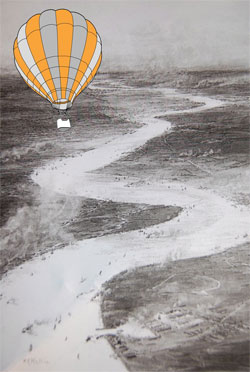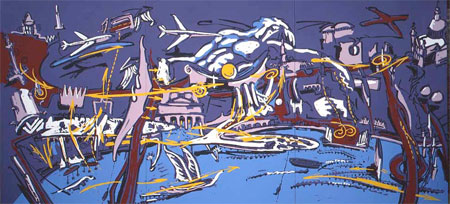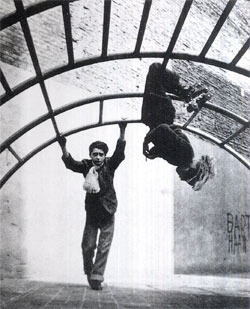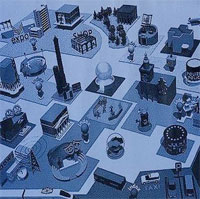Architecture Open Lecture Series 2010 /11
- University of Greenwich
- School of Architecture & Construction
- Mansion Site, Avery Hill Campus
- Bexley Road, Eltham, London SE9 2PQ
- Norbert Singer Lecture Theatre (M055)
Wed 13 October 2010 18.30
Ed Frith
WA(L) KING OF THE G(R)ATE WAY: PSYCHO-GEOGRAPHIC WANDERINGS – WILL MERLEAU-PONTY AND ZIZEK LAND ON AIR STRIP ONE?

From Michel de Certeau to Richard Long, city to country, aerial panoramas, and labyrinthine wanderings. Set the zooming, walk the Gateway, wake the history: take Eames’s film The Powers of Ten (with original credit to Kees Boeke), cross with David Lean’s Great Expectations; the moment where Pip is turned upside down by Magwitch. Merleau-Ponty’s primacy of body movement experiences a Zizek’s filmic ‘All that Solid Melts into Air’ moment; a body scale from the cosmic to microcosmic, ten by ten, to a revolving moment. Our walking investigations combine geographical, psychological, and narrative with a projected architecture leaning on writers such as Auster, Ballard, Sinclair, Perec and Carter. The scale of the study touches on the immensity of the Gateway on the edge of the continental shelf, yet at the same time the phenomenological scale of the body. It is searching for an architecture concerned with identity and the body, whether it is the visit to the graves at Cooling with Jools, Queen Victoria and Falstaff in the background, or Wittgenstein visiting the library of memories at the heart of old and new Medway. Where the projects travel from the Garden Shed to the Container Terminal, a place of mental travail. The investigations come from Atelier 11, Thinkers and Makers, a research and design unit in the School that has been digging narratives across the Thames Gateway, a slice of the expansion and regeneration of London and its hinterlands to the East, this critique asks for a broadening and deepening of scale. Is there an argument for an architecture of walking mediation, or perhaps for the leaping and ripping the plasma and layers of graphene apart to reveal the apocalyptic dark underbelly … quick, squeeze Mies, catch Fevvers, and fly.
Ed Frith is Diploma Programme Leader and Principal Lecturer at the University of Greenwich, School of Architecture & Construction, and Design Tutor for Atelier 11, Thinkers and Makers. Architect/Director of Moving Architecture, Hackney based laboratory and research practice constructing through performance and architecture. He studied at Bristol, Cambridge, was a visiting fellow at Princeton and Columbia, worked with a number of practices ranging from Diller Scofidio to Julian Harrap Architects and was Berthold Lubetkin’s gardener . With Moving Architecture he has developed performance pieces and buildings with choreographer Caroline Salem in London, China, New York and Spain. He has written for a number of magazines, such as Building Design, Architects Journal. ‘Draw Like a Builder, Build like a Writer’ based on the work of Atelier 11 with Alex Graef is published in The Humanities in Architectural Design. A Contemporary and Historical Perspective (Routldge 2010).
References
Introduction
Berman, Marshall: All That’s Solid Melts into Air, MIT 1984
Rykwert, Joseph: The Idea of the Town, MIT 1988 The Introduction
Thom, Rene Traces of Dance: Choreographers’ Drawings And Notations
1994 Dis Voir
1 Representation
Aerial Ground and Zooming
De Certeau, Michel: The Practices of Everyday Life (Berkeley, CA: University of California Press, 1984) ISBN–10: 0520236998. (See Part III – Spatial Practices Particularly Chapter VII – Walking in the City, Chapter IX – Spatial Stories)
Merleau–Ponty, Maurice: Phenomenology of Perception, 1945; Translation Colin Smith Routledge 1998; ISBN 0415278414
Zizek, Slavoj: Living in the End Times, Verso 2010; ISBN-10: 184467598X
Auster, Paul: New York Trilogy, City of Glass
Eames, Charles & Ray: Powers of Ten, Film for IBM 1968
Boeke, Kees, Cosmic View, 1957
1 Walking On Across and Around
Richard Long, Around Rome and London
Chatwin, Bruce: Songlines
Rykwert, Joseph: The Idea of the Town, MIT 1988 p65 The First Furrow
Sinclair, Iain: London Orbital
Krauss, Rosalind, The Originality of the Avant Garde and Other Modernist Myths, MIT 1990
Self, Will: Walking to Hollywood
Sennett, Richard: Fall of the Public Man.
Bachelard, Gaston: Poetics of Space
Solnit, Rebecca: Wanderlust,
2 Gateway Games
With projects by
Lawrence Becker, Tim Wolfe Murray and Heidi Lee
Atelier 11 Blog
Dickens, Charles: Great Expectations film – David Lean
Sinclair, Iain: Downriver
Berman, Marshall: All That’s Solid Melts into Air, MIT 1984
Perec, Georges: Life, A Users Manual
Ballard, J G: The Atrocity Exhibition
Sinclair, Iain: Hackney, that Rose Red Empire,
4 Air Strip One
Carter, Angela: Nights at the Circus,
Orwell, George: 1984
13th October 2010 Ed Frith



